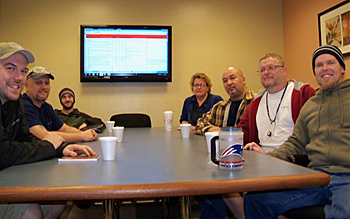ONLINE EXCLUSIVE: Web Industries Idea System
Todd Pihl and Bruce Bumpus
 |
|
| First-shift extruding personnel evaluate improvement ideas; an electronic idea board is on the wall. From left to right: Jesse Schumacher, Rene Taillon, Mike Scott, Brenda Annunziata, Wigberto Gonzalez, Norm Evans and Tom White. |
An industry leader for more 40 years, Web Industries helps companies bring their products to market by offering state-of-the-art development, converting services and contract manufacturing. The company also offers value-added services such as proactive supply-chain management and product life-cycle cost modeling.
A key component in controlling costs over the life cycle of any product is finding or creating new levels of efficiency through continuous process improvements. Employees at Web Industries’ Hartford, CT, (Web Hartford) facility have developed an effective “idea system” that empowers employees to look for, discover and implement new efficiencies.
Why did Web Hartford choose to start an idea system? Like any business, we are facing ever-increasing competition from domestic and off-shore competitors. The question we asked ourselves was, “How do you create a competitive edge to beat the competition?” The answer lay in tapping into the innovation of our workforce.
A traditional “suggestion box” approach had been tried. Most of the ideas that it generated were changes to someone else’s workflow. This approach proved demoralizing; the affected operations didn’t have input into the changes to their own workflow. When we read the book, Ideas are Free, by Alan Robinson and Dean Schroeder, we knew that we had found the answer to our question of how to tap into the creative energy of our fellow employees. We launched our new idea system, designed to encourage innovative, useful suggestions from people in all areas of the organization.
Idea System Highlights
Six different idea groups meet once a week to propose small ideas they feel would make their jobs more efficient and/or easier. If a promising idea is agreed upon by the group, it is developed and implemented within a short time period. Each group has a $200 weekly budget for materials or other items they require to implement a selected idea. When we first implemented this process, it was easy for the various groups to come up with many ideas for investigation. Over the years, as workflow has been continuously improved, the groups have had to work harder and think further outside the box to find new improvement areas.
When an idea group hits the wall looking for improvements to its jobs, we’ve found that focusing on problems outside of the usual operation re-energizes them. Putting fresh minds on unfamiliar challenges can result in amazing lateral thinking and fresh solutions.
We have tried several variations of physical white boards located throughout the plant to record group ideas and solutions. We also experimented by putting the “board” on our network, available to all employees, and projecting it for everyone to read during group meetings. As we adapted and changed our system, we discovered better methods. The key is to keep gathering employees’ input because they understand the real issues and problems happening on the plant floor every day.
This system works because it empowers our employees to have a say in how they can improve their work areas without having to go through a cumbersome, top-heavy approval system. We use metrics to track how many completed ideas we have each month and how many completed ideas each individual department has to its credit.
’Small Ideas,’ Major Impact
All of these seemingly “small ideas” give us a competitive edge and keep us in the game by tapping into the rich resources of our greatest asset, our employees. Five years later, most of our employees have read Ideas are Free. We have conducted two plant shutdowns so employees could attend the authors’ seminars at our local community college. This showed everyone at the facility that we were serious and committed to making this system work. Both authors have visited us in the Hartford facility to review our idea system and give us a “tune-up,” assuring that we continue to improve it.
Our idea system has revolutionized the way Web Hartford does business. Our employees are empowered to address the problems they face in their daily work. These efforts to improve their work cells and work flow have led to:
- Reduced waste, cost and variability
- Improved product quality
- Improved service to our valued customers.
Keeping management out of the way and empowering our knowledgeable workforce are keys to these achievements. Our employees have developed and implemented thousands of small, incremental product, process, quality, safety and service improvements during the past five years, providing us with a real edge over our competition.
The number of ideas we complete each month is our measure of innovation and continuous improvement. Through our idea system, our team is empowered to make products and provide services that cannot be rivaled by our competitors. A healthy idea system creates a hard-to-replicate competitive edge that can make the difference in the competitive global landscape. All it takes is a commitment to trying new ideas and a fresh approach to management challenges.
Todd Pihl is the Web Hartford general manager. Bruce Bumpus is the continuous improvement manager at Web Hartford.


